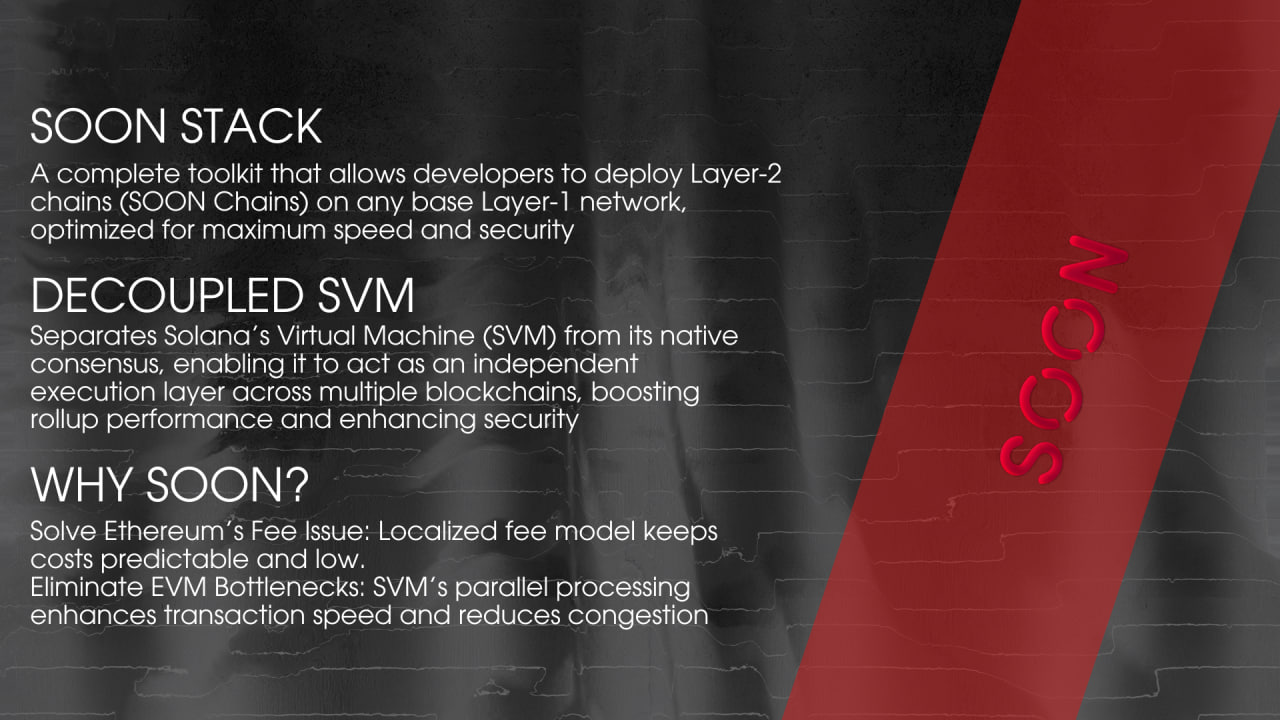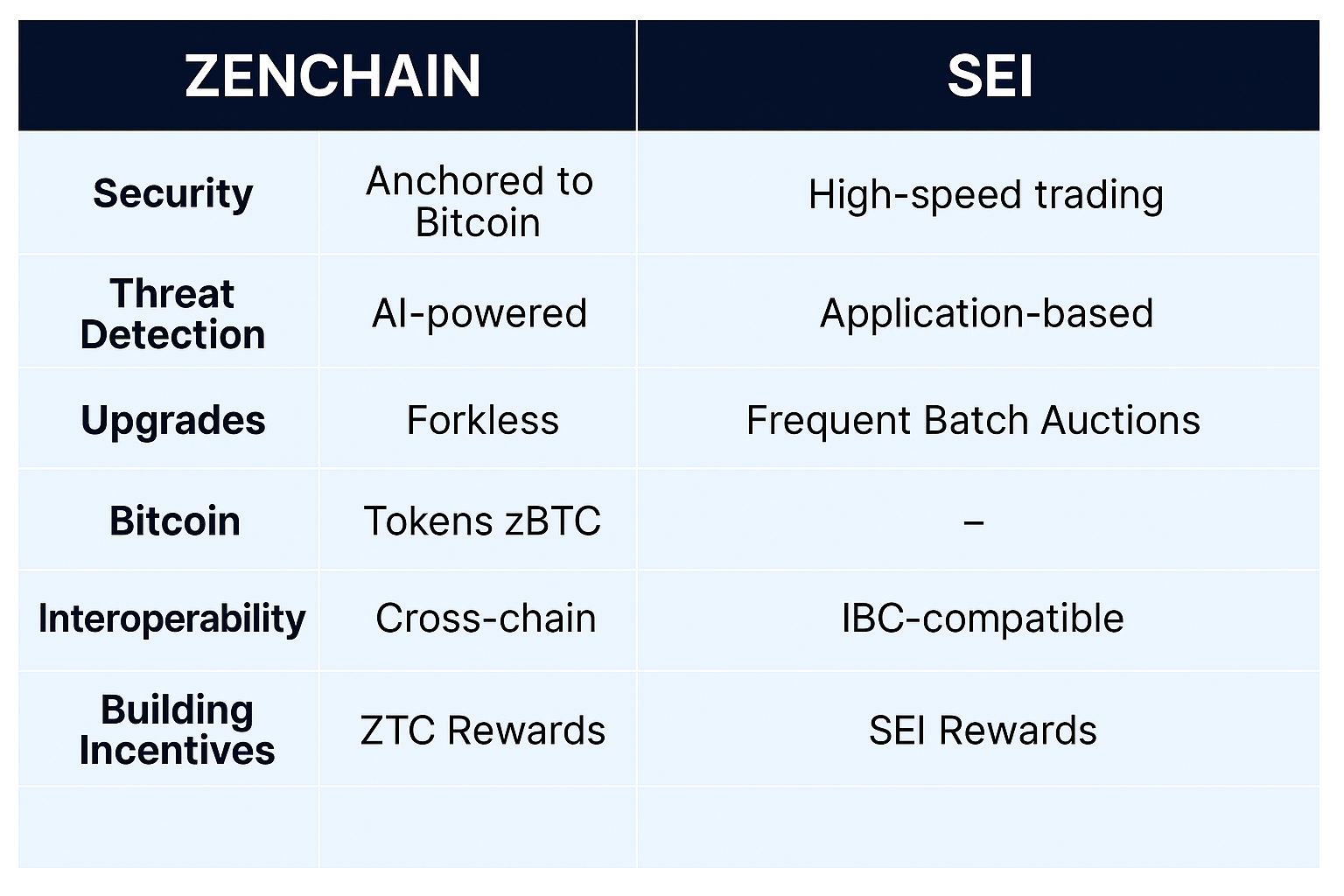SOON is set to transform the Layer-2 landscape by delivering unprecedented speed, scalability, and efficiency through its unique integration of Decoupled Solana Virtual Machine (SVM) technology. This innovative solution allows the creation of high-performance Layer-2 chains that can seamlessly operate on any Layer-1 network, with Ethereum being the first target for deployment.
SOON Mainnet: Elevating Ethereum with Superior Layer-2 Infrastructure The SOON Mainnet, built on top of Ethereum, represents a significant advancement in Layer-2 capabilities. Managed by the SOON team, it’s designed to offer a far more efficient execution environment than what Ethereum natively provides. By harnessing the SOON Stack, users and developers can tap into faster transactions, lower fees, and a smoother overall experience on Ethereum.
SOON Stack: The Complete Toolkit for Deploying Layer-2 Solutions At the core of SOON’s innovation is the SOON Stack — a powerful suite of tools designed to facilitate the deployment and management of Layer-2 chains on any underlying Layer-1 network, such as Ethereum. These new Layer-2 solutions, known as SOON Chains, run on Decoupled SVM technology, delivering unparalleled transaction speeds, interoperability, and cost savings across various blockchain ecosystems.
Decoupled SVM: Redefining Layer-2 Execution The Decoupled SVM is a revolutionary concept that sets SOON apart. Traditionally, the Solana Virtual Machine (SVM) has been tightly bound to Solana’s consensus mechanism, limiting its use to that ecosystem. SOON detaches the SVM from Solana’s native consensus, turning it into an independent execution engine that can be implemented across multiple Layer-1 platforms. This opens the door for superior performance and security in rollup designs, allowing diverse chains to benefit from SVM’s processing power while maintaining their own consensus and security structures.
Why SVM is Key to Unlocking Blockchain Efficiency Current blockchain frameworks, particularly Ethereum, are plagued with inefficiencies like high transaction costs and slow performance, especially during times of network congestion. SOON’s use of the SVM directly addresses these challenges.

-
Solving Ethereum’s Fee Problem: One of Ethereum’s major pain points is its global fee market, where a surge in demand for certain transactions (like NFTs or DeFi) can drive up fees for every user on the network. SOON solves this with SVM’s localized fee model, which separates transaction costs for each individual smart contract. This prevents unrelated transactions from driving up fees and ensures users only pay for the actual resources their transaction uses, even during periods of heavy demand.
-
Eliminating EVM Performance Constraints: The Ethereum Virtual Machine (EVM) processes transactions one after another in a single-threaded system, creating bottlenecks that lead to slow transaction times and rising fees. By contrast, SVM employs parallel transaction processing, allowing it to handle multiple operations at once. This not only boosts throughput but keeps the network fast and efficient, even when traffic is high.
SVM: The Ultimate Virtual Machine for Scalability and Speed The Solana Virtual Machine (SVM) is designed to be the gold standard in blockchain virtual machines, offering advantages that make it the most capable engine for high-performance decentralized applications. These benefits include:
Parallel Processing with Sealevel: Unlike other virtual machines that process transactions one by one, SVM’s Sealevel technology allows it to execute several smart contracts at the same time. This increases overall throughput and minimizes transaction delays, making SVM the go-to choice for developers who need speed and efficiency. Localized Fee Structure: The SVM fee model ensures each smart contract operates independently, so users aren’t hit with higher fees due to activity in other parts of the network. This keeps costs low and ensures a more predictable, user-friendly experience. Hardware Optimization and Security: SVM leverages Solana’s decentralized network to distribute the workload efficiently across its nodes. This maximizes resource use and strengthens the network’s defenses against potential threats like DDoS attacks or smart contract vulnerabilities, ensuring the platform remains both fast and secure. Conclusion: SOON is Leading the Charge for Next-Gen Layer-2 Development By introducing Decoupled SVM and the comprehensive SOON Stack, the SOON project is setting a new standard for Layer-2 performance. Tackling Ethereum’s inefficiencies and surpassing the limitations of the EVM, SOON is unlocking a new world of possibilities for decentralized applications with faster transactions, lower costs, and stronger security. With SOON, the future of blockchain scalability and efficiency is finally within reach, benefiting both developers and users in a rapidly evolving digital landscape.




评论 (0)